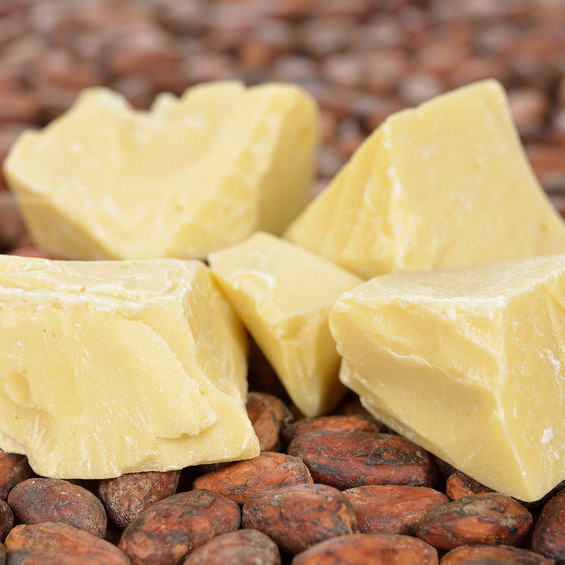
Cocoa Butter
What is Cocoa Butter?
Cocoa butter, a saturated fat stable at room temperature, is obtained from cocoa tree beans. It is used in chocolate, candy, baking, cosmetics and pharmaceuticals. The butter has a light yellow color and may have a chocolate aroma in the natural form, unless it’s removed by deodorization.
Most commonly used in milk chocolate and white chocolate, cocoa butter is responsible for the following characteristics in chocolate:2
- Hardness at room temperature
- Brightness or gloss
- Pleasant melting behavior when placed in the mouth
Origin
The Olmecs (1500-400 BC) are believed to be the first population to discover and use cocoa. Later the Mayans and Aztecs cultivated the tree in Southern Mexico. Following the fall of the Aztec civilization, cocoa was brought to Spain where the first chocolate factory was established in Barcelona. From there, the use of cocoa butter spread into England where chocolate was made available to the public by Fry and Sons Company in 1847.2 In the U.S., Milton Hershey began using itin producing chocolate after attending the World Fair in Chicago.
Function
Cocoa butter’s predominant combination of triacylglycerols of palmitic, stearic and oleic acids allows it to be solid at room temperature and to melt in a narrow temperature range of 32°C to 35°C ( 89°F to 95°F).1
It serves the following functions and attributes of chocolate:
- Viscosity control
- Emulsification
- Appearance – glossiness
- Snap or brittleness when broken apart
- Heat stability
- Mouthfeel
- Flavor release
- Shelf life
Nutrition
Cocoa butter is composed mainly of saturated and mono-unsaturated triglycerides. It does not contain carbohydrates or proteins.
The following make up the present fats:2
- Triacylglycerols: 95%
- Diacylglycerols: 2%
- Monoacylglycerols: <1%
- Polar lipids: 1%
- Free fatty acids: 1%
Commercial production
To make cocoa butter, cocoa beans are harvested, fermented, dried and roasted followed by alkalinization (flavor development).
After this, the beans are sent through a grinder that separates the hulls to produce nibs which are ground to produce cocoa mass (cocoa liquor). Cocoa liquor is pressed to extract the butter using hydraulic presses. Cocoa butter can also be separated using solvent extraction.2
Application
Cocoa butter is used for thinning chocolate and making chocolate coatings. It is seldom used in baking applications because it hardens at room temperature, making it less than ideal for creaming methods unless combined with other liquid fats.
Cocoa butter has a shelf life of 2-5 years when stored in an airtight light-proof container.
The following guidelines provide the percentage of cocoa butter used by chocolate type, according to the EU Directive:1
Dark chocolate
- Cocoa butter: ≥ 18%
- Total dry cocoa solids: ≥ 35%
- Dry non-fat cocoa solids: ≥ 14%
Milk chocolate
- Total dry cocoa solids: >25%
- Dry non-fat cocoa solids: >2.5%
- Dry milk solids: >14% obtained by partly or wholly dehydrating whole milk, semi- or full-skimmed milk, cream, or from partly or wholly dehydrated cream, butter or milk fat, milk fat (>3.5%)
- Cocoa butter: >20%
FDA regulation
The FDA has established a standard of identity for white chocolate to include 20 percent cocoa butter. According to the document, white chocolate contains a minimum of 20 percent cocoa butter, a minimum of 14 percent of total milk solids, a minimum of 3.5 percent milk fat, and a maximum of 55 percent nutritive carbohydrate sweeteners under 21 CFR 163.124(b)(2).
The FDA also provides guidelines for substitution of cocoa butter under Code of Federal Regulations Title 21.
References
- Afoakwa, E O. Chocolate Science and Technology. 2nd ed., John Wiley & Sons Inc, 2016.
- Clercq, N., Kadivar, S., Walle, D., Pelsmaeker, S., Ghellynck, X., & Dewettinck, K. “Functionality of cocoa butter equivalents in chocolate products.” European Food Research and Technology 243.2 (2016): 309-321.
- Center for Food Safety and Applied Nutrition. “Labeling & Nutrition – Guidance for Industry: Standard of Identity for White Chocolate; Small Entity Compliance Guide.” U S Food and Drug Administration Home Page, Center for Biologics Evaluation and Research, www.fda.gov/Food/GuidanceRegulation/GuidanceDocumentsRegulatoryInformation/LabelingNutrition/ucm059076.htm.
- “CFR – Code of Federal Regulations Title 21.” Accessdata.fda.gov, www.accessdata.fda.gov/scripts/cdrh/cfdocs/cfcfr/CFRSearch.cfm?fr=184.1259.

